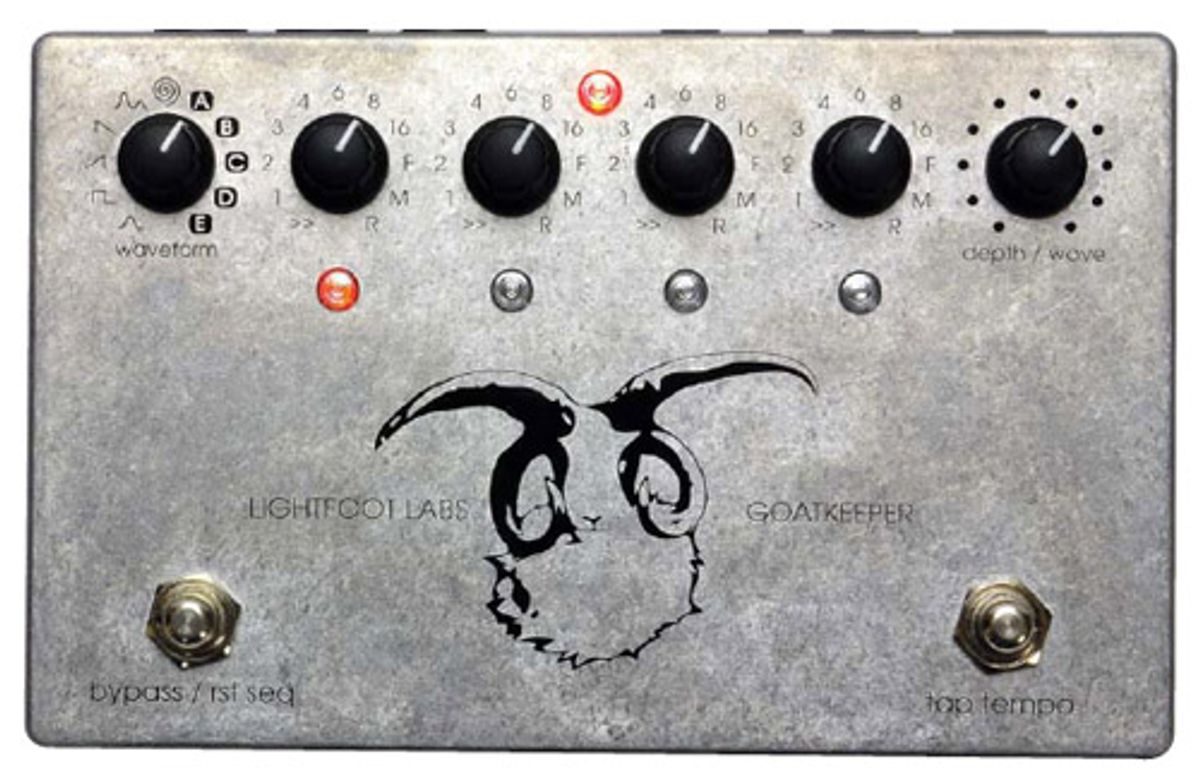
One-of-a-kind tremolo with non-traditional sounds
| Download Example 1 | |
| Download Example 2 | |
| Download Example 3 | |
| Download Example 4 | |
| Download Example 5 | |
| Clips recorded with 1991 Ibanez Sabre into Marshall JMD:1 on JVM410H preamp model, emulated speaker out via XLR to E-MU USB0404 into Cubase 5 44.1k 24bit. | |
Built for Business
The Goatkeeper’s control set includes two footswitches. The left switch turns the unit on or off, as indicated by a bright red pilot light. The right switch is a tap tempo button to set tremolo or LFO (low-frequency oscillator) speed. Six black knobs run across the top of the unit—all far enough away from the footswitches to prevent accidentally fouling your setting with an errant kick. Each knob is actually a rotary switch, except for the far right knob, which is a standard pot used to control waveform depth and amplitude when recording your own wave into the unit. There is also a small pot on the back of the device for adjusting output volume.
The first knob lets you select one of six standard waveforms including square, sine, sawtooth, and echo, and provides another five positions for user-customized waveforms. Four discrete LFO Time Division knobs help you create complex tremolo patterns. You can also set the Time Division switches to skip a step, multiply a step by various values from 1 to 16, or generate random steps.
Along with Audio In and Out jacks, the back panel has an LFO Out jack for driving other devices, a Sync In jack to control the LFO rate with an external click track, and an Expression In jack, which lets you use an expression pedal, along with the depth/wave knob, to control the LFO rate.
Complex Controls, Big Rewards
Guitarists who know their way around analog synths or know the basics of LFOs will definitely have a leg up programming this pedal. It’s much more complex and capable than an amp tremolo channel or even a typical tremolo pedal, so you can anticipate a great deal of trial and error on the road to mastering the GK3. But it’s capable of some amazing and unique sounds that range from the positively bizarre to otherworldly, yet totally musical and rhythmic guitar sounds.
Getting a handle on tremolo rates isn’t all guesswork. Each Time Division knob has its own LED that indicates the speed or rate of the division in the sequence. Getting a straightforward tremolo setting is fairly easy: You select a sine wave and set each Time Division knob to 1. The result is a traditional tremolo sound similar to a blackface Fender tremolo, but with more punch. Selecting a square wave and maxing the depth knob creates an attack-heavy, chopping tremolo sound, while the reverse sawtooth summons psychedelically flavored reverse-guitar effects. And these are just a few of the nuggets that can be discovered hiding in the circuits of this box.
The Verdict
As a standard tremolo, the Goatkeeper is exceptional. But to use it exclusively for that purpose is like buying an iMac for its calculator. And while it took some experiments that really annoyed the neighbors and my cat, I started to grasp the Goatkeeper’s mojo pretty quickly. My experience with synths shortened the learning curve somewhat.
The Goatkeeper can generate potent noise-rock effects suitable for experimental- and post-rock sounds. It’s also very capable of broken and scary industrial guitar rhythms, so an avant-garde player could probably build an entire set around it. Indeed, the Goatkeeper may be overkill for the tremolo traditionalist, but for the adventurous player, a unique world of oscillation awaits.
Buy if...
you want traditional trem sounds and highly tweakable, non-traditional effects.
Skip if...
you only need enough tremolo to play Link Wray’s “Rumble.”
Rating...
Street $340 - Lightfoot Labs - lightfootlabs.com |
| Tone Games 2010: 30 Stompboxes Reviewed | Next in TIME-BASED: Malekko Heavy Industry Ekko 616 |
